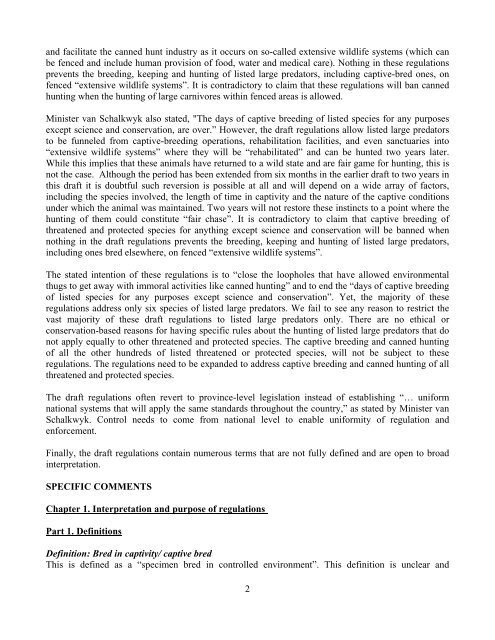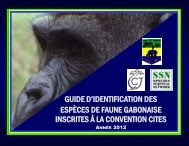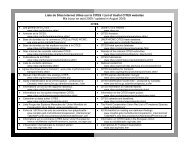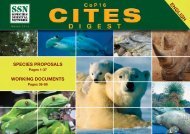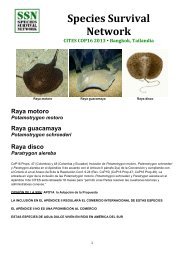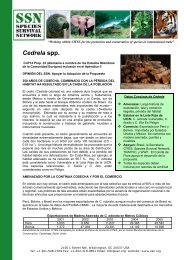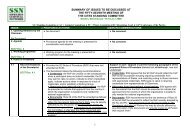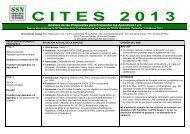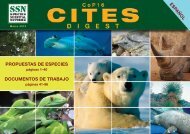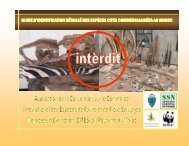SSN's Comments on South Africa's Regulations on Threatened and ...
SSN's Comments on South Africa's Regulations on Threatened and ...
SSN's Comments on South Africa's Regulations on Threatened and ...
You also want an ePaper? Increase the reach of your titles
YUMPU automatically turns print PDFs into web optimized ePapers that Google loves.
<strong>and</strong> facilitate the canned hunt industry as it occurs <strong>on</strong> so-called extensive wildlife systems (which can<br />
be fenced <strong>and</strong> include human provisi<strong>on</strong> of food, water <strong>and</strong> medical care). Nothing in these regulati<strong>on</strong>s<br />
prevents the breeding, keeping <strong>and</strong> hunting of listed large predators, including captive-bred <strong>on</strong>es, <strong>on</strong><br />
fenced “extensive wildlife systems”. It is c<strong>on</strong>tradictory to claim that these regulati<strong>on</strong>s will ban canned<br />
hunting when the hunting of large carnivores within fenced areas is allowed.<br />
Minister van Schalkwyk also stated, "The days of captive breeding of listed species for any purposes<br />
except science <strong>and</strong> c<strong>on</strong>servati<strong>on</strong>, are over.” However, the draft regulati<strong>on</strong>s allow listed large predators<br />
to be funneled from captive-breeding operati<strong>on</strong>s, rehabilitati<strong>on</strong> facilities, <strong>and</strong> even sanctuaries into<br />
“extensive wildlife systems” where they will be “rehabilitated” <strong>and</strong> can be hunted two years later.<br />
While this implies that these animals have returned to a wild state <strong>and</strong> are fair game for hunting, this is<br />
not the case. Although the period has been extended from six m<strong>on</strong>ths in the earlier draft to two years in<br />
this draft it is doubtful such reversi<strong>on</strong> is possible at all <strong>and</strong> will depend <strong>on</strong> a wide array of factors,<br />
including the species involved, the length of time in captivity <strong>and</strong> the nature of the captive c<strong>on</strong>diti<strong>on</strong>s<br />
under which the animal was maintained. Two years will not restore these instincts to a point where the<br />
hunting of them could c<strong>on</strong>stitute “fair chase”. It is c<strong>on</strong>tradictory to claim that captive breeding of<br />
threatened <strong>and</strong> protected species for anything except science <strong>and</strong> c<strong>on</strong>servati<strong>on</strong> will be banned when<br />
nothing in the draft regulati<strong>on</strong>s prevents the breeding, keeping <strong>and</strong> hunting of listed large predators,<br />
including <strong>on</strong>es bred elsewhere, <strong>on</strong> fenced “extensive wildlife systems”.<br />
The stated intenti<strong>on</strong> of these regulati<strong>on</strong>s is to “close the loopholes that have allowed envir<strong>on</strong>mental<br />
thugs to get away with immoral activities like canned hunting” <strong>and</strong> to end the “days of captive breeding<br />
of listed species for any purposes except science <strong>and</strong> c<strong>on</strong>servati<strong>on</strong>”. Yet, the majority of these<br />
regulati<strong>on</strong>s address <strong>on</strong>ly six species of listed large predators. We fail to see any reas<strong>on</strong> to restrict the<br />
vast majority of these draft regulati<strong>on</strong>s to listed large predators <strong>on</strong>ly. There are no ethical or<br />
c<strong>on</strong>servati<strong>on</strong>-based reas<strong>on</strong>s for having specific rules about the hunting of listed large predators that do<br />
not apply equally to other threatened <strong>and</strong> protected species. The captive breeding <strong>and</strong> canned hunting<br />
of all the other hundreds of listed threatened or protected species, will not be subject to these<br />
regulati<strong>on</strong>s. The regulati<strong>on</strong>s need to be exp<strong>and</strong>ed to address captive breeding <strong>and</strong> canned hunting of all<br />
threatened <strong>and</strong> protected species.<br />
The draft regulati<strong>on</strong>s often revert to province-level legislati<strong>on</strong> instead of establishing “… uniform<br />
nati<strong>on</strong>al systems that will apply the same st<strong>and</strong>ards throughout the country,” as stated by Minister van<br />
Schalkwyk. C<strong>on</strong>trol needs to come from nati<strong>on</strong>al level to enable uniformity of regulati<strong>on</strong> <strong>and</strong><br />
enforcement.<br />
Finally, the draft regulati<strong>on</strong>s c<strong>on</strong>tain numerous terms that are not fully defined <strong>and</strong> are open to broad<br />
interpretati<strong>on</strong>.<br />
SPECIFIC COMMENTS<br />
Chapter 1. Interpretati<strong>on</strong> <strong>and</strong> purpose of regulati<strong>on</strong>s<br />
Part 1. Definiti<strong>on</strong>s<br />
Definiti<strong>on</strong>: Bred in captivity/ captive bred<br />
This is defined as a “specimen bred in c<strong>on</strong>trolled envir<strong>on</strong>ment”. This definiti<strong>on</strong> is unclear <strong>and</strong><br />
2


